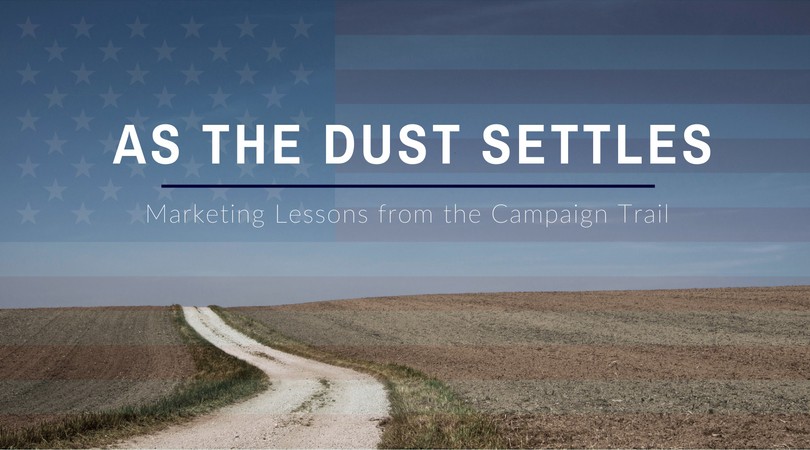As the Dust Settles…Marketing Lessons from the Campaign Trail

Posted By Colleen Irish on December 13, 2016
There is no denying that the 2016 presidential election was among the biggest marketing events of the year. In fact, I think most people would agree it sucked up most of the air all year long. Nothing short of a historic World Series could get people’s attention off it for any sustained period of time. So we would be remiss if we didn’t take a little time to reflect on some of the more relevant and useful communications lessons.
Here are a few that may be worth taking into consideration as you plan your communications campaigns for the year ahead.
Don’t Underestimate the Power of Micro-Demographics
As voters, pundits, and market analysts are still coming to terms with the surprising results, one clear factor that’s emerged is the concentrated and detailed attention paid to key demographic audiences. The strategy became about identifying areas of greatest potential and zeroing in on them relentlessly.
In the political arena, this strategy of capitalizing on key populations paid off in Electoral College votes. In PR, we often preach to the already converted or try to talk to too many audiences, rather than thinking strategically about where we can find new converts and make the greatest gains. Market research, including customer feedback forms, industry surveys, and social listening, can help in this process IF you ask the right questions and don’t just listen to what you want to hear, but what your customers and prospects are really saying.
Make your Message Compact and Meaningful
This may seem like the most obvious rule in the world, but it’s amazing how few companies actually follow it. If you can’t boil down your message in three or four words, you’re likely to lose your audience: “Yes We Can,” “Stronger Together,” “Feel the Bern,” “Make America Great Again.” Whether you like any of these personally, there’s no denying their memorability and impact. This same lesson can be applied to your own business messaging as well. Rather than trying to stand behind multiple claims, statements and promises, ask yourself what is the single key message that defines your business and answers your customers’ needs. When building your messaging framework, think about:
- The needs you are trying to meet with your product or services.
- The key components of your value proposition (i.e. what you offer customers and why/how this is different from what your competitors offer), essentially why you exist!
- The main benefits of your products and services that you can drive home when crafting your messages.
- Test your messages using a focus group of potential buyers to see how they react, get their feedback on potential buying behavior based on what they’ve heard.
Keeping it simple will help you prioritize and crystallize information about your business to ensure consistency when speaking with media or stakeholders, and will also help your customers clearly understand and remember what your business stands for.
Predictive Analytics Must Be Paired with Emotional Sentiment
We all know that data science took a hit in this election. As close as the day prior to the election, the New York Times' Upshot gave Hillary Clinton an 85% chance of victory while the Huffington Post’s model showed Clinton with a 98% chance of winning. But, as we learned in the days/weeks following the election, this was all based on probability and an overreliance on poll data. Data analyst teams weren’t considering voter emotions in their calculations and last minute voters who may have kept their preferences quiet, even from pollsters.
The lesson we learned here is you can’t always rely on data alone. As seen even from current consumers’ mobile and social buying patterns, emotion is playing an increasingly important role in decision-making today. Data analytics is still a very powerful tool to incorporate into your marketing and brand-building strategies, but it’s important to balance it with a true understanding of prevailing customer sentiment. Good data modeling must be an ongoing process that allows for check-ins and adjustments.
Understand and Appreciate the Power of Social
Social media is, of course, a big part of any PR strategy, providing businesses with a platform to publish content and quickly amplify their news to an even larger audience. And it has played a huge role in recent election cycles. President Obama’s tweet in 2012 announcing his victory became the most shared tweet in history with 660,000 retweets. He continued his strong presence on social media, especially on Twitter (@POTUS) in an effort to create a more transparent Administration and to connect with the American people.
Bernie Sanders made considerable traction in social media, specifically with the Millennial generation. His campaign spent more than $350,000 in advertising targeted to this younger demographic on Facebook and Instagram winning over almost 85% of young voters before losing to Hillary Clinton in the primaries. It was the biggest social media advertising campaign ever taken on by a political party, reaching more than 750,000 people in Iowa.
Of course, the president-elect has taken social media use to a characteristically unprecedented level. Will this prove to be good or bad? Too soon to tell -- even Twitter’s Jack Dorsey is a bit conflicted about it. But in the meantime, more people will be following the President of the United States from more spots around the world than ever before.
So what this might likely mean for marketers is a growing expectation from consumers to hear from people in positions of authority. CEOs who have been reluctant to engage in these channels might rethink their strategies. Every campaign, whether political or not, needs to have a well-thought-out social strategy in place that takes into account the evolving needs, expectations, and preferences of the audience. If done correctly, social media presents an opportunity to build brand awareness and personality on a platform that lends itself to less formality. Using images, video, memes and even humor can capture the attention of your target audience and offer unique glimpses into the company’s personality and mission, creating tighter and more loyal connections to a brand.
I’m sure the lessons of this past election will become clearer and more telling as we gain some distance from the events that so consumed our nation’s consciousness for more than a year. And in the end, if we take the time to listen, we’ll be better equipped to communicate in compelling and effective ways.



